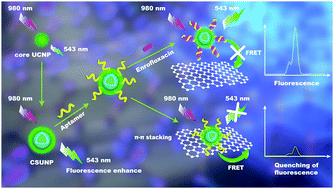Aptamer-modified sensitive nanobiosensors for the specific detection of antibiotics†
Abstract
The overuse or abuse of quinolone antibiotics such as enrofloxacin (ENR) in veterinary medicine results in the presence of their residues in food and environment. Thus, a sensitive method is needed to detect them. Herein, we demonstrate a fluorescence resonance energy transfer (FRET) based aptasensor for ENR detection, using core–shell upconversion nanoparticles (CSUNPs) as an energy donor and graphene oxide (GO) as an energy acceptor. The core–shell structure and Gd3+ doping significantly increased the fluorescence intensity of CSUNPs and the FRET efficiency. The ENR aptamer was conjugated to CSUNPs through ligand exchange, and the π–π stacking between the aptamer and GO brought the aptamer-modified CSUNPs to the surface of the GO sheets, resulting in the formation of a CSUNP–GO complex and the subsequent quenching of CSUNP fluorescence. As a result, an aptasensor was established with the fluorescence of CSUNPs correlated with the ENR concentration within the range of 0.976 ng mL−1 to 62.5 ng mL−1, allowing ENR to be detected at a limit of 0.47 ng mL−1. This method reduced the detection limit by approximately 13-fold in 2 h compared to the commercial enzyme-linked immunosorbent assay (ELISA) kit. The aptasensor could also be applied to detect ENR from commercial milk powder samples with a detection limit of 1.59 ng mL−1, which was far below the regulated maximum residue limit of ENR in milk. The aptasensor could not detect other antibiotics, suggesting its good specificity towards ENR. Our work demonstrates a highly selective, sensitive and cost-effective method for detecting antibiotic residues in veterinary medicine. Since the aptamer can be switched to one recognizing another antibiotic, the aptasensors are used as a plug-and-play platform that can detect a variety of antibiotics.



 Please wait while we load your content...
Please wait while we load your content...